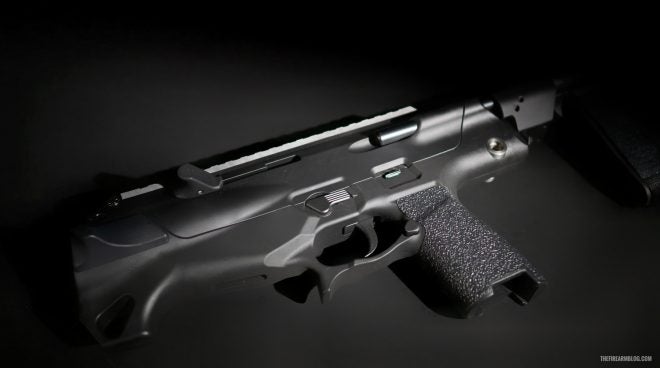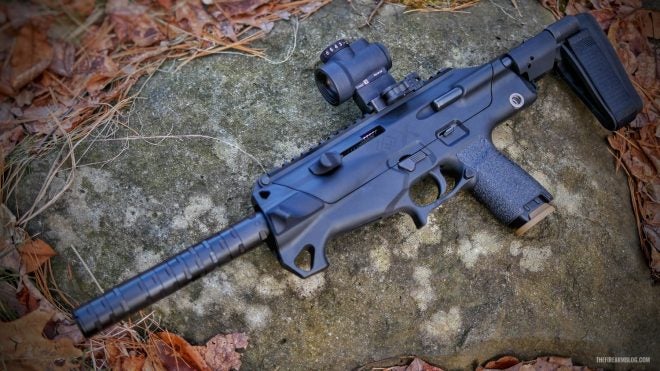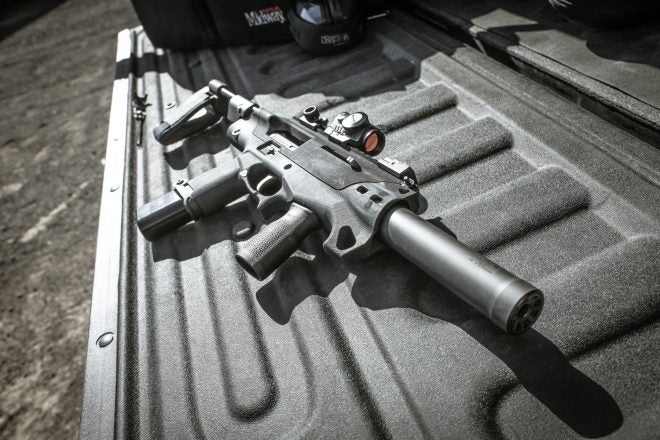About six months ago I started a conversation with the team at Fire Control Unit (FCU) on Instagram – a bit of friendly banter about some of my favorite pistol caliber carbines versus their latest release. Of course, we had reported the initial announcement of the FCU X01 (EXO ONE) in late 2017 and the availability of the Personal Defense Weapon Chassis (PDW) chassis a few months ago, so I was familiar with the overall concept. As a recap, because the Sig Sauer P320 (and P250) weapons are completely modular, the entire registered unit/receiver can be moved between frames in less than thirty seconds, changing a compact pistol to a full-size competition gun with the only requirement being a few unregistered parts. Discovering the treasure trove of endless possibilities early on, FCU designed and built a PDW around the the actual firearm guts of the P320 pistol. The process, I believe, is a rare defining moment in firearms history and the future development of small arms.
TFB REVIEW: Fire Control Unit X01 PDW – The Future Of Small Arms
To be perfectly honest, initially I had little interest in the X01; my interests usually orbit around purpose-built guns and not universal adaptations on previous designs. For example, even with my love and faith placed squarely on the shoulders of GLOCK pistols, I had never considered owning a KPOS or RONI chassis. As great as these pistols are, the PDW or Pistol Caliber Carbine (PCC) versions feel complicated, bulky and unnecessary. While you gain a shoulder stock and some modularity, you are still locked in to a full GLOCK receiver.
But, as social media helps encourage, my interest in the X01 started to grow with a few clicks. I also had a chance to take a deeper dive into it’s design and applications and finally had the realization that the overall vision of what FCU was attempting, was much bigger than a Space Force looking chassis with a pistol brace. But I’m getting ahead of myself.
As many of you are already painfully aware, my love for B&T Firearms starts here on the blog, winds down a near obsessive path, and ends up at our social media outlets. And the here’s where my story about the friendly banter with the FCU team resumes. Apparently during the design phase of the X01, the team had considered the B&T TP9 to be a worthy competitor. While drawing parallels between a compact PDW, with a folding brace or stock, that can be suppressed and used grip-fed magazines, FCU was respectful to the B&T gun, history and its design features.

Still, the comparison gauntlet was thrown, and I suggested a head to head shootout between the X01 and the TP9. But before we take a look at a direct comparison, I think we need to understand the FCU designs and intended use cases.

Specifications/Details:
- Sig P320 or P250 slide assembly, magazine release, and FCU required.
- Compatible with full size, carry, tacops, x-carry, or compact P320 or P250 slides chambered in 9mm, .40, or .357 SIG.
- X-5 compatible on request (see options).
- Milspec 1913 picatinny top rail
- Rear 1913 picatinny rail for arm brace, buttstock, or sling mounts
- Integrated ambidextrous slide-lock charging handle assembly
- Rear dual QD Sling mounts
- Three (3) fore-end M-Lok® accessory slots
- Dual proprietary handstops
- Muzzle compatible with SRD9 Suppressors when requested (more models to be tested soon) when a compact slide is paired with a full-size threaded barrel (Silencerco® model recommended)
- Glass-filled nylon & stainless steel construction
- Transformation happens in moments and is fully reversible
- MSRP: $399-$650 depending on options

Just so we are clear, the P320 (or P250) pistol fire control unit is not included in the cost of the X01. If you already own a P320, depending on the size, you may not need to buy any additional parts. Without a host pistol, users will need to invest in a Sig pistol and the parts needed for transfer into the X01. Figure a $400-$500 additional investment.
As for the additional options like a threaded barrel, pistol stabilizing brace and a home for a manual safety (if your Sig is outfitted with one), they are all served up á la carte on the FCU website.
Since, at the time, I didn’t have a P320 for donation parts, the good people at FCU we’re nice enough to allow me to borrow a complete X01 unit for testing. The setup included a registered fire control unit, meaning the X01 was shipped to my FFL. However, as a chassis, even with all the added options, the X01 can be shipped directly to your door.
properties/characteristics:
The X01 is well made and refined, almost as if FCU made a conscious decision to avoid the the look and feel of a Tapco accessory (sorry Remington, but it’s true). Not being a materials scientist, I can’t speak as to the “glass-filled nylon” build process, but the end result is what feels opposite of injection molded plastic. The surface of the frame and top cover is smooth but tactile.

Anal retentive neat freaks and photographers who like to keep their guns pristine, will enjoy the fact that the surface of the X01 doesn’t hold fingerprints or smudges easily. Cleaning oils and mild solvents (Ballistol) had no visible effects on the finish. The grip texture is aggressive but not gritty.

The form factor (I hate that term) is well thought out and comfortable. Obviously, much of the ergonomics is defined by the angle of the magazine and magazine well, solidifying the grip angle nearly in stone. But if you can comfortably handle a P320, a strong hand grip on the X01 will feel at home. Quick disconnect sling mounts can be found on either side, up and behind the back strap and before the Picatinny rail attachment for braces and stocks.

Honestly, the trigger guard area could be larger, with additional space for a gloved finger (get your mind out of the gutter). The mag release is a direct swap from the P320 and its placement on the grip is right about perfect for me.

The X01 is specifically designed for the optional SB Tactical-designed brace from Sig. The guide bars for the brace fit through a channel on either side of the receiver. The channels pass through the lower receiver module as well as the top cover which adds to the rigidity of the whole system.
As good as the collapsing brace is, the complete Sig device adds a good deal of weight and length to a PDW meant to be light and small. A folding brace or a stock, if you are planning to go down the NFA road, would make a great upgrade.

As we move towards the business end of the X01, my annoyance level starts to spike. Not for anything that the FCU design team had built, mind you, but at the stupid regulations and laws surrounding the National Firearms Act (NFA). PDW’s are built for vertical fore grips and the X01 suffers along with the rest of the industry. The design team decided to manufacture a combination angled fore grip and hand stop nearly at the muzzle. If you decided to pay your $200 tax and proceed directly to ‘GO’, the FCU team has provided owners with and MLOK slot in between the trigger guard and the AFG. Hidden under the hand stops on either side are two more MLOK attachment points.
Internals:
From the outside, the internals of the X01 feels like it should have all the complexity of a pinball machine: adapting an enclosure around an existing firearm has the potential for an engineering disaster. An over complicated mess of springs and 3D printed parts that come with a risk of excessive tolerances to make everything function properly.


Thankfully, this isn’t the case. The X01 has a simplistic beauty that would make other pistol chassis weep with jealousy. After verifying that the weapon is unloaded, extend the brace out so that the rods clear the channels in the top cover. Then, press forward on the silver button on the cover and lift, revealing the P320 internals. The process is similar to when Luke lifted the helmet off of Darth Vader’s head, but instead of revealing a beat up old white guy, it actually is a pristine and refined James Earl Jones (without all the drama of realizing you just killed your father in a lightsaber battle).

With the simplicity of the X01 comes familiarity – if you can field strip a Sig P320, you can breakdown this PDW without issue. After removing the slide, barrel and recoil spring and guide, basically all that is left is the fire control unit. The top cover retains the non-reciprocating ambidextrous charging handle system. Speaking of the charging handle, the left side can be used to lock the slide to the rear, whereas the right side can only be used to charge the weapon.

Of course, buyers of the X01 will want to follow the process in reverse to assemble their unit: the instructions provided by FCU are detailed and easy to follow. Don’t forget, you’ll need to transfer your magazine release and takedown lever into the chassis. For that reason, you may want to pick up spares to install permanently into the unit to save time, especially if you plan on swapping between P320 and X01 configurations frequently.

At the time of this initial disassembly I only had a few hundred rounds through the unit but I was surprised not to find a mess of residue inside. When not running suppressed, the muzzle is buried in the chassis about two inches back. But neither the top cover nor the lower receiver were excessively dirty. After about 1,000 rounds, the system itself was as dirty as a carbine would be with a similar round count.

Reassembly is as simple as doing everything in reverse, or simply following the FCU instructions. With practice, the whole setup goes from parts to PDW in two minutes or less.

The design of the X01 is ingenious, and I don’t throw that term around lightly. And I also don’t discount the design of the Sig fire control unit as being a major reason in why the the X01 is well thought about and executed. Obviously, with the work of a drop-in system completed for the P320/P250, the work of designing a chassis becomes much easier. However, a simplified, less refined design would be cheaper and easier to produce. And would probably be less reliable, heavier and more complex as a result.
Shooting the X01:
What should have been the most exciting part of this review, shooting this little PDW, was actually the most unsurprising. The X01 was boringly reliable; I didn’t experience a single stoppage in the five months that I’ve had it. It simply runs, as any well made firearm should.

Having said that, I had some cycling issues when running suppressed, which I was able to trace back to a stuck/ungreased piston in the silencer itself. Which leads me to an important side note. If you plan on running the X01 suppressed, the outer diameter of your silencer needs to be able to fit inside the inner diameter of the chassis. Obviously the Dead Air Odessa fits in nicely, but I also was able to run the Thompson Machine Poseidon, a pistonless kurz-sized can. FCU recommends running the Sig Sauer SRD9 which has an OD 1.38”. For reference, my SilencerCo Octane 45HD would not fit inside the X01. Remember, the tilting barrel operation of the P320along with the recessed muzzle requires an extra bit of clearance since the angled silencer will hit the chassis during cycling.

Back to the range. The recoil on the X01 is almost non existent, producing consistently flat shooting strings even under the quickest of trigger pulls. Again, if you know the P320 trigger and grip angle, everything should feel the same. 
As for the TP9 comparison, I can definitely see the origins – the size and overall profile are very similar. I do think that the TP9 is an overall smoother shooting gun, especially suppressed. While the TP9 does have its faults, the rotating barrel action, rather than the tilting barrel on the P320/X01, makes a noticeable difference in blowback and suppression levels. That could also be do in part to the TP9 suppressor which has a large amount of internal volume.
Still, I think the comparison is a bit unfair; the TP9 retails at about $1900 and requires another $1000 for the TP9 suppressor. Whereas a complete X01 will run you a little over $1000 and can handle a small selection of silencers that cost around $600. That’s a pretty large financial difference.
A more accurate comparison might be the USW frame and stock from B&T. However, the lack of a top rail and reduced real estate for a VFG and lights, may give the edge to the X01. But again, the comparison isn’t perfect.

Conclusions:
If you are an owner of a P320, like pistol caliber PDWs and appreciate its overall aesthetics, picking up the X01 is a no brainer. It is well made, functions flawlessly and is very affordable. It’s obvious that the FCU team put a lot of thought into the design, development and production of the X01. At four pounds, it’s fairly light. It takes Sig P320 magazines (obviously). And it can be run suppressed. What’s not to love?
Suggestions:
- Custom made (longer) barrels would help increase silencer compatibility, allow for the use of a compensator (not really necessary) and possibly help prevent debris build up inside the chassis. Besides, adding two inches of barrel should increase bullet velocities.
- Open up the trigger guard a bit
- AFG/handstop redesign – My personal preference would be a slender stop allowing for more room for hand placement.
The future of small arms
As significant as the X01 milestone is, more important are the implications the FCU design has on the firearm industry and the future of small arms. If you see a pistol or a PDW, think bigger. With a portable fire control unit and a competent design and engineering team, the sky is the limit. Imagine being able to custom configure AR15 style chassis’s exactly the way you want – no mix and match parts – all for a few hundred dollars a piece and without the need for an FFL transfer. Then you are free to drop your one registered unit into any system, be it PDW, SBR, carbine or rifle, and have a truly modular firearm.
Here we sit, a day after the DOJ has banned bump stocks – devices comprised of nothing more than molded plastic and springs. And yet we have not come to terms with how technology is rapidly outpacing our archaic laws. There are already companies designing 80% fire control units, meaning that with some basic tools, modular weapons can be made in workshops across the country. I could stand on a soap box for hours, shouting about individual liberties and technological advancement, but this is not the time or the place.
Thanks for reading TFB.
X01 Personal Defense Weapon Platform
The X01 (Exo One) Exoskeleton is a drop-in PDW upgrade for the Sig Sauer® P320® series of firearms that provides enhanced capabilities such as the ability to attach an SB Tactical™ arm brace or buttstock, such as those compatible with the SIG® MCX series (optional add-on).
The X01 enhances the original firearm’s manual of arms with its integrated charging handle, which provides an “HK®-style” downward release when locked to the rear. The fore-end of the weapon features M-Lok® slots, two of which come standard with specially designed handstops that integrate with the grip module’s contours.
MSRP: $399.00 – $699.00

Credit: firecontrolunit.com

Credit: firecontrolunit.com
 Your Privacy Choices
Your Privacy Choices
